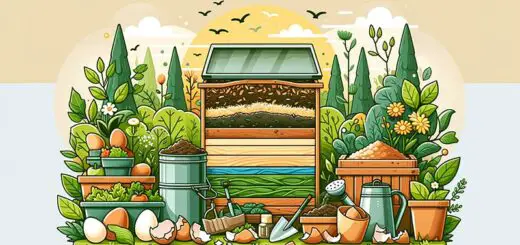Harvest Compost: When And How To Proceed
Are you looking for the perfect way to turn organic materials into rich fertilizers and soil amendments? Composting is an ideal solution – a great eco-friendly alternative with many benefits for soil health.
With the right approach, composting can yield incredibly nutritious ingredients that will give your plants’ roots all the minerals they need to grow and thrive.
However, harvesting compost isn’t always as simple as letting nature work its magic; this activity has a time and place.
In this article, we’ll look at when and in what way you should harvest compost so you can get maximum value from your efforts.
Understanding the Composting Process – A Guide to Compost Harvesting
Composting is a natural process when organic matter decomposes into nutrient-rich soil. Understanding the composting process is essential for anyone who wants to harvest high-quality compost for gardening or agriculture.
Composting involves a complex network of microorganisms that break down organic matter into dark and crumbly soil-like humus.
The process requires the right balance of carbon-rich brown materials, such as dead leaves and branches, and nitrogen-rich green materials, such as vegetable scraps and grass clippings.
Maintaining the right moisture level and aerating the pile regularly is also crucial to encourage decomposition.
We’ll explore the different stages of composting, from setting up a compost pile to harvesting and using the finished product.
Why You Should Regularly Harvest Your Compost
Regularly harvesting your compost provides many benefits for your garden and the environment. As the compost breaks down, it creates a nutrient-rich soil amendment that can greatly enhance the health and growth of your plants.
By removing the finished compost, you make room for new materials to break down and continue the cycle of creating fertile soil.
Beyond the direct benefits to your garden, harvesting your compost also reduces the amount of waste in landfills, helping to decrease greenhouse gas emissions.
So, whether you have a small backyard setup or a large-scale operation, regularly harvest your compost to reap the rewards for your plants and the planet.
What You Should Look for When Harvesting
When it comes to harvesting, it’s important to know what to look for to ensure success. The same principle applies when it comes to tone. Knowing what to look for can help you communicate effectively and avoid misunderstandings.
One thing to remember is pitch, which refers to the highness or lowness of your voice.
A high pitch can sound shrill or tense, while a low pitch can sound monotone or uninterested. Another factor is volume, or how loud or soft your voice is. A soft voice can convey intimacy or seriousness, while a loud voice can convey enthusiasm or authority.
Additionally, pace and rhythm can affect the tone of your voice. Speaking too quickly can make you sound nervous or rushed, while speaking too slowly can make you bored or uninterested.
By paying attention to these factors, you can better control your voice and achieve successful communication.
How to Separate Finished and Unfinished Compost
Composting is a simple and efficient way to reduce waste and enrich your garden with nutrient-rich soil. However, it’s important to separate finished compost from unfinished product.
Finished compost is dark and crumbly, whereas unfinished compost is still recognizable as the material it was made from. A good rule of thumb is to wait at least three months before harvesting your compost.
You’ll want to use a screen or sieve to sift out any larger debris or chunks, as they can be added back into the compost pile to continue breaking down.
Store your finished compost in a dry, covered area to prevent it from becoming too wet or losing nutrients. With these tips, your garden will thrive with healthy, nutrient-rich soil.
Tools Needed for Properly Harvesting Compost
Proper harvesting of compost requires some essential tools. First, a pitchfork or garden fork must turn the compost pile, ensuring all the material is broken down evenly.
Second, a pair of gardening gloves will protect your hands from any sharp or rough materials.
Additionally, a shovel or scoop is useful for transferring the compost to a container or garden bed.
Lastly, a compost thermometer helps monitor the pile’s temperature, allowing for proper decomposition. Investing in these tools makes harvesting easier and promotes a healthier and more sustainable environment for all.
Tips & Tricks for Easier Compost Harvesting
Harvesting compost can be a messy and challenging task. Luckily, there are tips and tricks you can follow to make the process easier.
One useful tip is to use a compost screen to sift out any large pieces of undecomposed materials. It will ensure that only the fine compost is left behind, making the harvest easier and faster.
Another trick is to water the compost pile a day before harvesting it. The moisture will help to bind the compost together, making it easier to transfer to your garden or storage bin.
Following these tips and tricks can make harvesting much smoother and more enjoyable.
End of Line
Composting can have many health benefits for you and the planet, but knowing how and when to harvest your compost properly is essential.
With some knowledge, you should now be equipped with the tools and techniques to manage and update your compost bin successfully.
Our comprehensive guide has outlined several steps for harvesting your compost, including understanding the composting process, why it’s important to keep up with regular harvesting, how to separate finished from unfinished compost, and what sort of tools are best suited for harvesting.
By being informed about the facts, properly preparing before starting any project, and conducting regular harvesting sessions, we have faith that you’ll feel comfortable handling your compost bin in no time.



